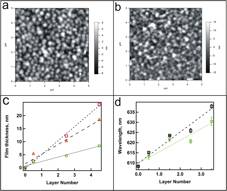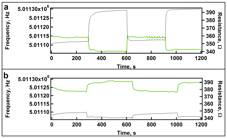
ACS PRF | ACS
All e-Annual Reports

43930-AC5
Designed Thin Films from Core/Shell Microgel Particles
For the past 15 years, polyelectrolyte based assembly of thin films has been used to design many different kinds of materials with a myriad of different functions. Thin films have tremendous utility for use in biomedical devices, sensors, and optical materials.
Inspired by these efforts, we have investigated the properties and potential uses of thin films constructed from microgel particles. In this report, we describe our recent work on such materials. A series of studies on microgel thin films is reported, wherein quartz crystal microgravimetry (QCM), surface plasmon resonance (SPR), and atomic force microscopy (AFM) have been used to probe the properties of microstructured polymer thin films as a function of film architecture and solution pH. Our findings suggest that the interaction between the negatively charged microgels and the positively charged PAH has a significant impact on the pH responsivity of the film. These effects are observable in both the optical and mechanical behaviors of the films. For the particular architectures described here, the results of these studies suggest that films with unusual bimodal swelling responses can be obtained using simple fabrication methods (see Scheme 1).
These studies have advanced the fundamental understanding of polyelectrolyte thin film structure and responsivity. By bringing to bear a number of analytical tools to study the problem, we have painted a picture of these films that has been previously unclear. Thus, these studies have greatly impacted the overall efforts in our group with respect to thin film fabrication, self-assembly, and film characterization. These studies have also allowed for the training of multiple students on associated projects, most notably Ms. Courtney Sorrell, a 5th year graduate student in the group. These efforts have been a tremendous scientific challenge for all students involved and have therefore provided an excellent opportunity for focused, fundamental investigations. Below we briefly describe some of the key results of these studies.
<>Results and Discussion
<>Thin films of pNIPAm-co-AAc (AAc) microgels, diameter ~220 nm in pH 3.0 buffer, and poly(allylamine hydrochloride) (PAH), were assembled using a spin-coating layer-by-layer (scLbL) technique. Initial characterizations (see Figure 1) of the film composition and build-up were performed with atomic force microscopy (AFM) and surface plasmon resonance (SPR).
<>
<>The most compelling data that illustrate the proposed bimodal swelling behavior shown in Scheme 1 are QCM measurements that illustrate for a film with microgels on top (Figure 2), the frequency and resistance change in opposite directions when the pH is increased from 3.0 to 6.5. Overall, we studied microgel-terminated films composed of 0.5 to 4.5 PAH/microgel bilayers and observed that in all cases as the pH is increased from 3.0 to 6.5, the motional resistance of the QCM increases and the frequency decreases. However, if we measure films where PAH forms the top layer, there are marked differences in the pH responses. These effects have been interpreted in terms of the bimodal swelling scheme illustrated in Scheme 1. A more detailed description of these studies has been published in Journal of Physical Chemistry B.
<>
<>Conclusions
<>We have used a combination of probe microscopy, optical, and acoustic methods to characterize the build-up of thin films composed of microgels and linear polycations. This combination has also elucidated the interactions and unusual morphology of the films with respect to pH responsivity. We have found that when microgel particles form the top layer, that the film responsds to changes in pH similarly to particles in free solution based on QCM experiments. However, the SPR tells a different story, indicating that the film underneath the particle layer becomes more highly cross-linked when the pH is increased above the pKa. Thus, these films represent materials of relatively simple design that display a fairly complex responsivity to external stimuli. Such films may be of interest for use in the area of soft actuators.
Scheme 1. Schematic depiction of the bimodal swelling model.
Figure 1. Film characterization data. (a) Shows an AFM image of a dry 3.5-bilayer film where microgels form the top layer. Axes are 5 mm. (b) Shows an AFM image of the same 3.5-layer film hydrated (in pH 3.0 buffer). Axes are 5 mm. (c) AFM thickness data: in pH 3.0 buffer (short-dashed line + orange squares); in pH 6.5 buffer (long-dashed line + pink triangles). (d) Surface plasmon resonance data. Light green circles=pH 3.0; black squares=pH 6.5. Figure 2. QCM time course data for a (a) 2.5-bilayer film (microgels form the top layer); (b) 3-bilayer film (PAH forms the top layer). For all QCM data, the pH starts out at pH 3.0. The light green solid line is the frequency vs. time measurements. The black dotted line represents the resistance vs. time measurements. 

